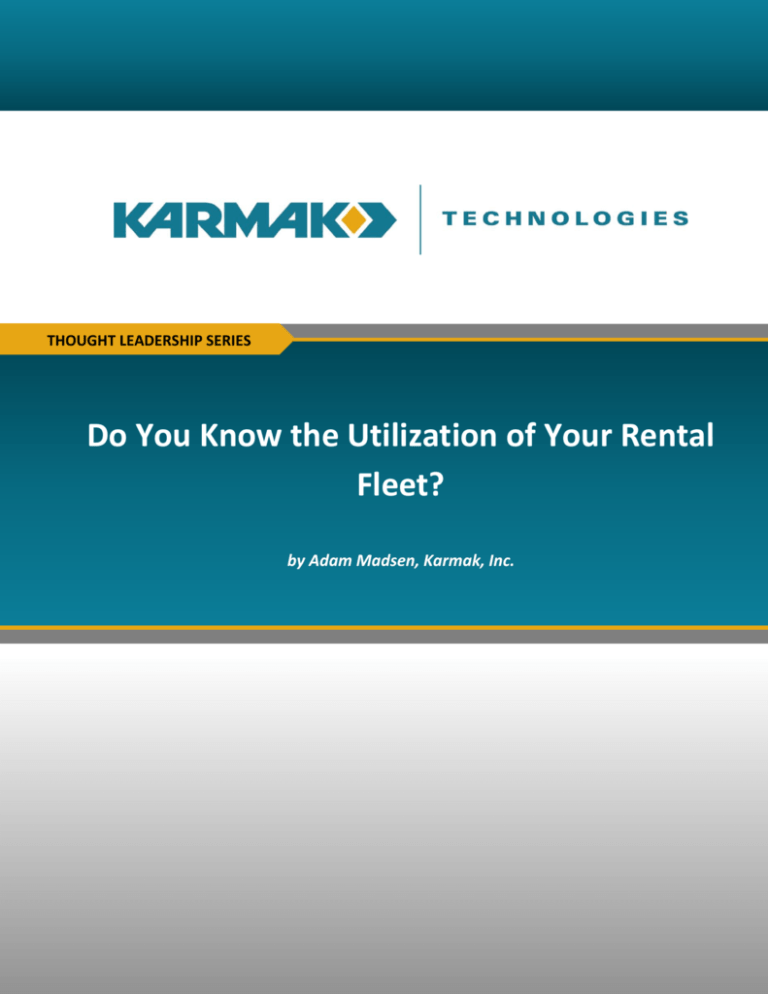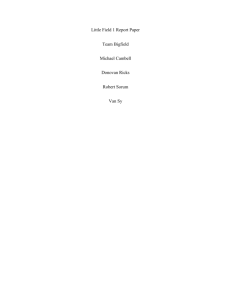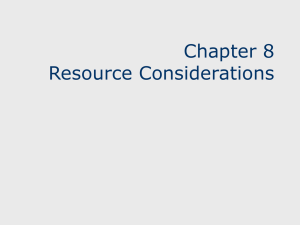
THOUGHT LEADERSHIP SERIES
Do You Know the Utilization of Your Rental
Fleet?
0
by Adam Madsen, Karmak, Inc.
Do You Know the Utilization of Your
Rental Fleet?
One of the struggles every CEO faces is how to manage their rental fleet without getting lost in the details. After
all, you have invested a great deal of capital to build your fleet and you want to make sure it is performing to the
best of its ability. Due to the importance of managing this asset, very quickly the question is asked “Which
numbers can I look at to manage my rental fleet?”
It would be a mistake to say you can only manage by looking at two numbers, however in the rental industry, the
foundation of all management should be looking at time utilization and dollar utilization. By looking at these two
numbers, you can quickly see how your fleet is performing. This should be done as a whole fleet, at each location,
as different equipment types, as any possible division of your fleet, and all the way down to the individual pieces
of equipment.
What is time utilization?
This seems to be controversial in the rental industry and there are several ways to do it correctly. You should
remember no matter how you choose to calculate it make sure you do it consistently and have strong benchmarks
for how you choose to do it.
Example: (Days Rented) / (Days Available) = Time Utilization Percentage
260 / 365 = 71.2%
What is dollar utilization?
Dollar utilization is a little simpler. It is calculated by dividing annual rental revenue by original acquisition cost.
Example: (Annual Revenue) / (Acquisition cost) = Dollar Utilization Percentage
$35,000.00 / $100,000.00 = 35%
The advantage to using this number is that it cannot be overly affected by outside influences. Typically, the
original cost of the asset and the total revenue collected in a specific time period are easily determined. This
allows very different types of equipment to be compared to each other.
What should my target utilization rates be?
Dollar utilization rates vary depending on what type of
rental industry you are in. In the graph at right, you can
see just how different utilization rates can be
depending in the type of business you are running.
It is important to keep a closer eye on dollar utilization
than time utilization. You can’t take time to the bank,
so time utilization alone does not help your business
much. You need to protect the dollar utilization side of
the equation and only use the time utilization number
to give yourself a clearer picture of what you are
seeing.
Karmak, Inc. | www.karmak.com | 800-622-6311
Page | 2
Do You Know the Utilization of Your
Rental Fleet?
The grid below will give you an idea of where you stand, how you got there, and what you need to do next. To
determine your unique utilization figures, use the formulas provided earlier. Once you have those, you can follow
the arrows to find the box that corresponds to the situation you are facing.
High time / High dollar
Situation: Dangerous Condition. Low dollar
utilization is to be avoided.
Situation: This is the goal. You are in good
shape.
How it Happened: Your rates are too low.
Renting equipment cheaply can be tempting,
but the math won’t add up.
How it Happened: Your fleets are performing
well.
What to do: You have to raise rates. Time
utilization might drop, but you can make more
actual revenue.
What to do: Don’t ignore your fleet. Consider
adding more units to grow overall business.
Low time / Low dollar
Low time / High dollar
Situation: Worst-case scenario.
Situation: Serious, but not dire.
How it Happened: Poor maintenance
practices leading to unplanned down time,
market changes, among other things.
How it Happened: High rates are keeping you
profitable, but demand may not be where it
should be on some units.
What to do: Remove underperforming
units.
What to do: Look at where you can capture
more demand or consider lowering rates to
increase time utilization.
Low
TIME UTILIZATION
High
High time / Low dollar
Low
DOLLAR UTILIZATION
High
Conclusion
What we learn from looking at these two figures is that they should be looked at as a pair. If we look at just one of
them, it would be easy to miss obvious trends and issues. Keep in mind that what you pay for equipment is a huge
factor in the overall equation. Some typically low dollar utilization items, such as specialty heavy equipment, are
very expensive.
When a piece of equipment is very expensive, consider buying used, late-model equipment. Saving $30,000 on a
used unit versus the cost of a new unit will dramatically improve your dollar utilization since your annual rental
revenue is divided by the original acquisition cost whether you bought new or used.
Karmak, Inc. | www.karmak.com | 800-622-6311
Page | 3
Do You Know the Utilization of Your
Rental Fleet?
With well-maintained equipment, most market rental rates are the same for a one year-old unit versus a four
year-old unit. We have seen several market segments that have benefitted from this approach, particularly when
using equipment with long expected life spans such as heavy trailers. If you use these basic management metrics,
you will find it is easier to have confidence in your rental fleet.
To learn more about growth areas within your rental business, download our article: “Do You Rent & Sell or Sell &
Rent?”
About Adam Madsen
Raised in Anchorage, Alaska, Adam Madsen began his career in the heavy-duty industry as a
young man working in a third-generation family-owned business: Drivetrain Distributors. He
later went on to work for Transwest, located in Denver, before joining the Karmak team in
2010 as a Project Analyst in the Research & Design department. He is currently the Manager
of Product Management, specializing in the Lease/Rental module. Being a part of the process
of building an ERP system has been a long-term goal of Adam’s, so seeing Karmak’s Fusion
evolve into a premier product is exciting. Adam received an Associate’s degree in
Communications, and is also a graduate of ATD Dealer Academy.
About Karmak
Karmak, Inc. is a leading provider of business management solutions for the commercial transportation industry.
With more than 30 years of heavy-duty experience, we offer a unique approach combining innovative technology,
strategic advice, and best practices. Our success programs produce measurable results by improving ROI,
mitigating risks, and achieving operational excellence.
Serving more than 1,800 locations across North America, Karmak is an employee-owned company with
headquarters in Carlinville, Illinois.
© 2014 Karmak, Inc. All rights reserved.
Karmak, Inc. | www.karmak.com | 800-622-6311
Page | 4








